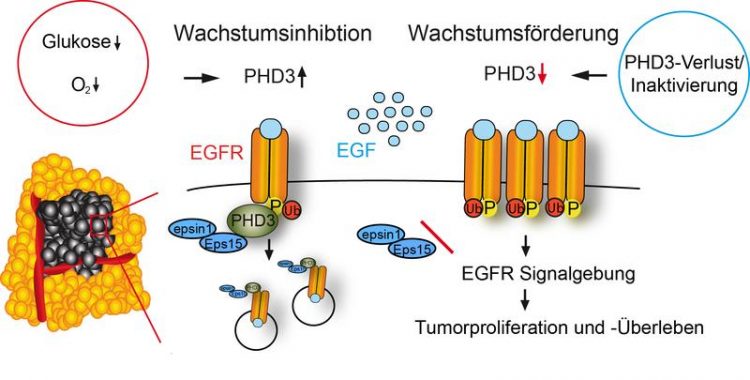Why cancer cells grow despite a lack of oxygen

The loss of PHD3 is a crucial step in the growth of human malignant brain tumours (glioblastomas). Garvalov et al./Nature Communications
Healthy cells reduce their growth when there is a lack of oxygen (hypoxia). This makes it even more surprising that hypoxia is a characteristic feature of malignant tumours. In two publications in the current edition of the “Nature Communications” journal, researchers from Goethe University and the Justus-Liebig-University of Giessen report on how cancer cells succeed at circumventing the genetic program of growth inhibition.
It has long been known that PHD proteins (prolyl-hydroxylase domain proteins) play a key role among the regulators of hypoxia. They control the stability of the hypoxia-induced transcription factors (HIFs) which govern the adaptation of cells to a lack of oxygen. The two teams led by Professor Amparo Acker-Palmer, Goethe University, and Professor Till Acker, Justus-Liebig-University, have now discovered that a special PHD protein, PHD3, also controls the epidermal growth factor receptor (EGFR).
In healthy cells, PHD3 responds to stressors such as a lack of oxygen by stimulating the uptake of EGF receptors into the cell interior. Growth signals are down-regulated by this internalisation. “We have discovered that PHD3 serves as a scaffolding protein, binding to central adapter proteins such as Eps15 and Epsin1 in order to promote the uptake of EGFR into the cells,” says Acker-Palmer. This process is disrupted in tumour cells due to the loss of PHD3. As a result, the internalisation of EGFR is suppressed, which leads to overactivity of EGFR signals, and thus to uncontrolled cell growth.
The research team was able to show that the loss of PHD3 is a crucial step in the growth of human malignant brain tumours (glioblastomas). The tumour cells thus become refractory to the growth-inhibiting signals under hypoxia. “Clinically, this discovery is highly relevant, because it shows an alternative mechanism for the hyperactivation of the EGF receptor that is independent of its genetic amplification. It can be therapeutically suppressed by EGFR inhibitors,” explains Till Acker, a neuropathologist at the University of Giessen.
“Our work shows an unexpected and new function of PHD3 on the interface of two currently red-hot research areas: Oxygen measurement and EGFR signalling,” Acker-Palmer explains. “This once again proves how significant growth receptor internalisation is to the development of cancer.” This connection was already shown by the research team in 2010 for tumour angiogenesis (Sawamiphak et al, Nature 2010).
Publications:
Henze et al: Loss of PHD3 allows tumours to overcome hypoxic growth inhibition and sustain proliferation through EGFR; Nature communications 25.11.2014; DOI 10.1038/ncomm6582
Garvalov et al.: PHD3 regulates EGFR internalization and signalling in tumours, Nature communications 25.11.2014, DOI: 10.1038/ncomms6577
Information: Prof. Amparo Acker-Palmer, Institute for Cell Biology and Neuroscience and the Buchmann Institute for Molecular Life Sciences, Campus Riedberg,Phone ++49(0)69 798- 42563, Acker-Palmer@bio.uni-frankfurt.de.
Prof. Till Acker, Institute of Neuropathology, University Clinic Giessen and Marburg GmbH, Arndtstraße 16, 35392 Gießen, Phone ++49(0)641 99-41181, till.acker@patho.med.uni-giessen.de
Goethe University is an institution with particularly strong research capabilities based in the European financial metropolis of Frankfurt. It celebrated its 100th anniversary in 2014. Founded in 1914 by liberal citizens of Frankfurt with private funds, the University has devoted itself to fulfilling its motto “Science for the Society” in its research and teaching activity right up to the present day. Many of the founding donors were of Jewish origin. In the last 100 years, Goethe University has produced pioneering contributions in the fields of social, societal and economic sciences, chemistry, quantum physics, brain research and labour law. On January 1st, 2008, it achieved an exceptional degree of independence as it returned to its historical roots as a privately funded university. Today it is one of the ten universities that are most successful in obtaining external research funding and one of the three largest universities in Germany with Clusters of Excellence in medicine, life sciences and humanities.
For more information, visit www2.uni-frankfurt.de/gu100
Publisher: President of Goethe University, Frankfurt am Main. Editor: Dr. Anne Hardy, Advisor for Scientific Communication, Marketing and Communication Department, Grüneburgplatz 1, 60323 Frankfurt am Main, Tel: ++49(0)69 798-12498, Fax: ++49(0)69 798-761 12531, hardy@pvw.uni-frankfurt.
Media Contact
All latest news from the category: Life Sciences and Chemistry
Articles and reports from the Life Sciences and chemistry area deal with applied and basic research into modern biology, chemistry and human medicine.
Valuable information can be found on a range of life sciences fields including bacteriology, biochemistry, bionics, bioinformatics, biophysics, biotechnology, genetics, geobotany, human biology, marine biology, microbiology, molecular biology, cellular biology, zoology, bioinorganic chemistry, microchemistry and environmental chemistry.
Newest articles

Silicon Carbide Innovation Alliance to drive industrial-scale semiconductor work
Known for its ability to withstand extreme environments and high voltages, silicon carbide (SiC) is a semiconducting material made up of silicon and carbon atoms arranged into crystals that is…

New SPECT/CT technique shows impressive biomarker identification
…offers increased access for prostate cancer patients. A novel SPECT/CT acquisition method can accurately detect radiopharmaceutical biodistribution in a convenient manner for prostate cancer patients, opening the door for more…

How 3D printers can give robots a soft touch
Soft skin coverings and touch sensors have emerged as a promising feature for robots that are both safer and more intuitive for human interaction, but they are expensive and difficult…





















